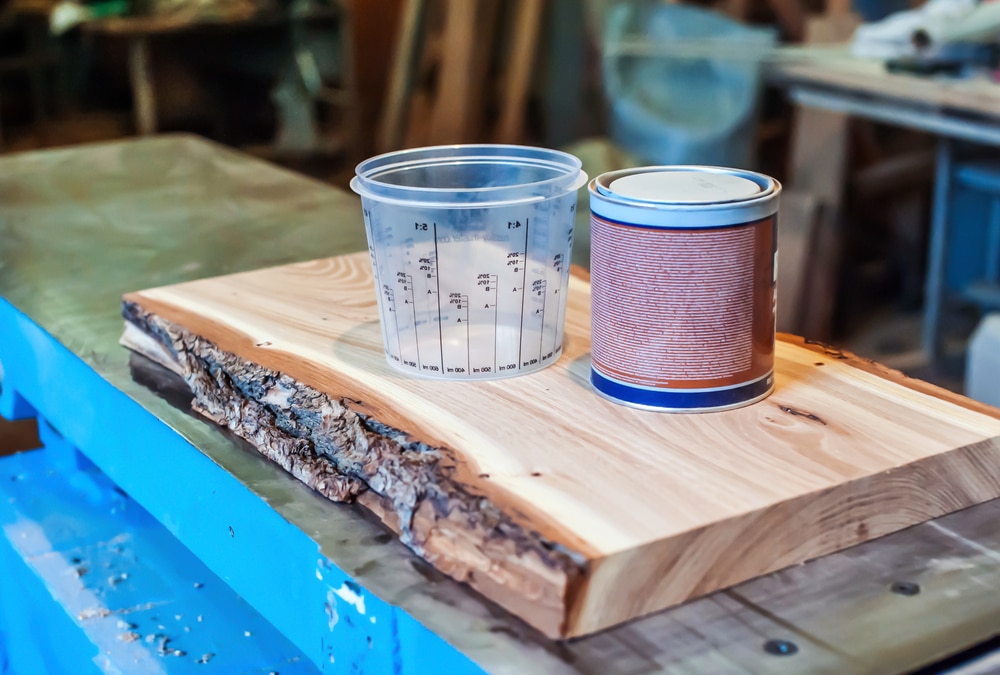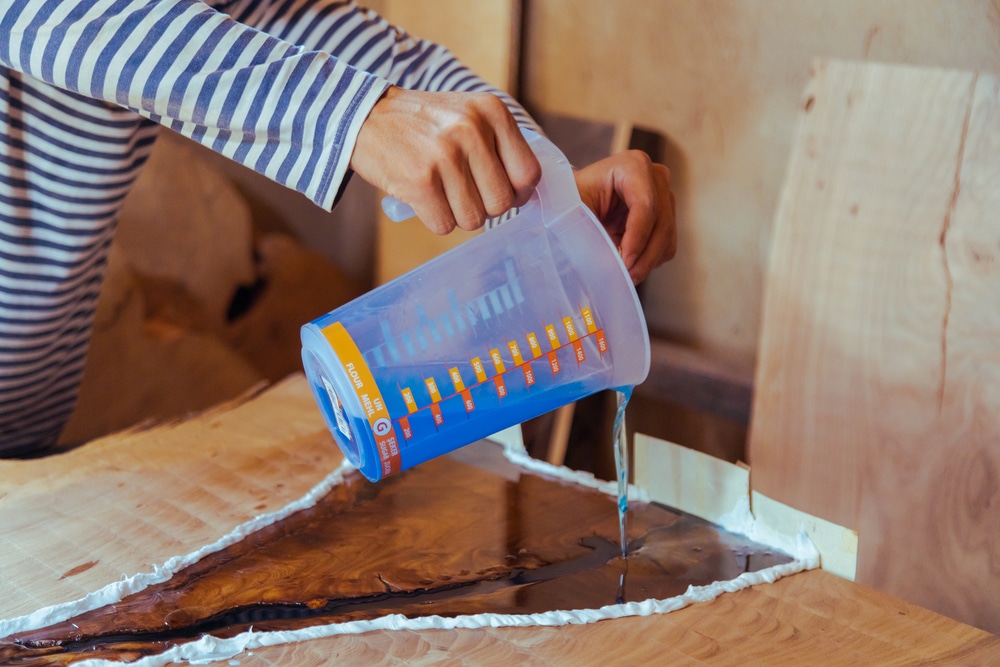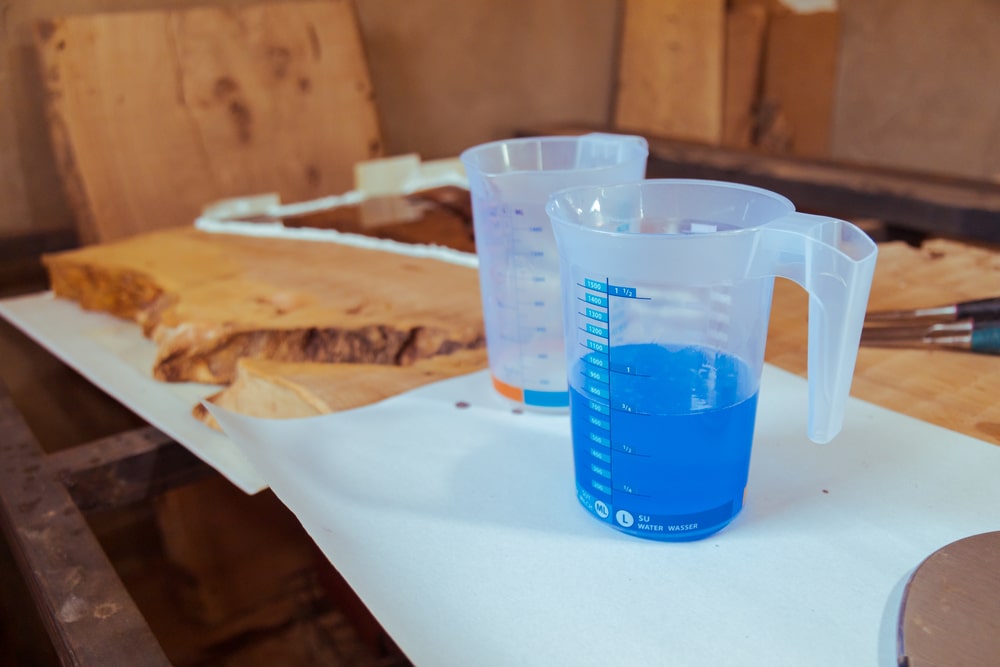Epoxy resins have become increasingly popular in woodworking due to their versatility, but there are many such products on the market containing a range of different chemicals and other technical specs.
How do decide which product is best suited for your project? What factors do you need to look out for?
In this article, we’ve compiled a list of five high-quality epoxy resins, each with different intended uses. We explain:
- Why each is best suited to certain kinds of projects
- What they shouldn’t be used for
- How to choose the best product for your project, and how to use it safely.
Let’s get into it!
Table of Contents
Why Epoxy Resin for Woodworking

Epoxy resin is a type of adhesive that is very popular in woodworking due to its strength, heat resistance, chemical resistance, and inoffensive, almost glass-like appearance that is compatible with all sorts of projects.
These properties make it highly effective not only as an adhesive but also as a design tool.
For example, one popular way to use epoxy is to fill in knotholes in tables made from wooden pieces with natural defects!
Top Epoxy Resins for Woodworking
There are many different brands and individual epoxy products out there.
These are by no means the only quality products available, but here’s a list of five great products to get started with that have high quality and versatility! Each is best suited to a different kind of project.
Top pick for tabletop application: MAS Table Top Pro
This is a resin designed primarily for use on table tops, bar tops, and other flat surfaces like signs. It is designed to be highly compatible with colored powders, inks, and paints.
- 30-minute working time at 75˚F
- Sandable after 24 hours at 75˚F.
Top pick for artistic projects: ArtResin
As the name implies, this resin is designed specifically for artistic applications!
It is designed to be less susceptible than other resins to yellowing and other cosmetic changes, non-toxic, easy to use, and compatible with a wide range of arts and crafts projects.
- Resistant to yellowing
- Extremely safe in all ways compared to other options
- Easy to work with
- Not suitable for heavy-duty work.
Top pick for boats and other marine uses: AeroMarine Laminating Epoxy Resin
This resin is designed for use on boats and other structures exposed to water long-term.
As you would expect, this resin is primarily designed to be more durable, strong, and waterproof than other epoxy resins.
- 12 hour cure time at 70˚F per coat
- Multiple coats required.
Top pick for making epoxy structures: MagicResin Deep Pour & Casting Epoxy Resin
This resin is designed to create very thick, clear, durable blocks or other shapes of plastic.
You can build large structures almost entirely out of this resin, without worrying that cracks or other effects will occur deep within the resin to ruin its clarity.
- Two options with different pour depths and curing times
Bonus top pick: Flexepox
This resin is designed to have extreme adhesive properties while maintaining flexibility after setting, having a slightly more gel-like consistency rather than a completely solid plastic consistency.
This is great for applications in which the resin is likely to be bumped into or moved around as it can absorb shocks without cracking or breaking apart!
This makes it great for use on boats alongside the AeroMarine resin.
- 75 minute working time at 72˚F
- Initial cure time of 3-4 hours at 72˚F
- Workable cure time of 7-10 hours at 72˚F in most cases
- Workable cure time of at least 24 hours for high loads.
Factors to Consider When Choosing Epoxy Resin

Three key factors to consider when choosing the right epoxy resin for a certain project include:
Viscosity
Resins with higher viscosity are thicker and more difficult to pour, spread, and generally work with. They are also generally stronger, however.
High-viscosity resins work great as coatings, gap fillers, and glues. Lower viscosity resins are better for embedding objects into gaps and creating intricate designs or filling molds.
Curing time
Some resins take longer to set and dry than others. Whilst this means the project takes longer, it can be very useful.
For example, it allows you to reshape the resin during the curing process, remove bubbles that may arise, prevent cracking, and generally ensure the product sets as perfectly as possible.
Resistance
Resins differ in how resistant they are to various external factors like light, heat, water, chemicals, and impact.
While higher resistance is almost always preferred in itself, it usually translates to a longer curing time, higher price, and a higher viscosity.
Some forms of resistance are only particularly important for certain kinds of projects, so some projects may be better suited to less resistant epoxy resin products.
Resin products marketed for particular purposes aren’t just a scam; there are real differences between these products in terms of these factors. Choosing the right epoxy resin can be not only a matter of effectiveness but also safety.
For example, if you’re using epoxy resin to repair a boat, it is very important that you choose a marine-grade epoxy resin designed to be exposed to water long-term. A hole in a boat is nothing to mess around with!
Epoxy resins designed for artistic applications are usually thinner than resins designed for tabletop applications because they need to be easy to work with so the artist can undo mistakes and manipulate the resin with more fine detail.
Casting resins are designed for use in molds or designs like the natural wooden table mentioned earlier. These resins are designed to fill up a large volume and retain that form.
Safety Precautions While Working with Epoxy

Other than marine safety, there are some other important safety concerns when it comes to working with epoxy resin.
Epoxy resins are made from potent chemicals that, if mishandled, can be profoundly harmful to your skin, airways, eyes, the environment, and even hormonal systems. These can have effects on fully grown adults, developing children, and even unborn children.
To ensure safety while working with epoxy, it is strongly recommended that you:
- Wear protective eye gear
- Wear a respirator mask
- Wear protective gloves and other skin covering
- Work in a well-ventilated area away from food as well as children, pets, and other unprotected individuals
- Thoroughly clean up and dispose of any spills
- Do not use any tools or containers with the epoxy resin that you will use for any other purposes, as this can lead to harmful forms of chemical contamination.
Final Thoughts
Epoxy resin is aesthetically appealing, versatile, and robust, but it comes in different forms.
The best resin for an artistic project will be quite different from the best resin for a boat repair or a tabletop coating.
Using the right epoxy resin for your project can have a transformative effect on the safety, artistic design, and durability of your woodworking projects!
